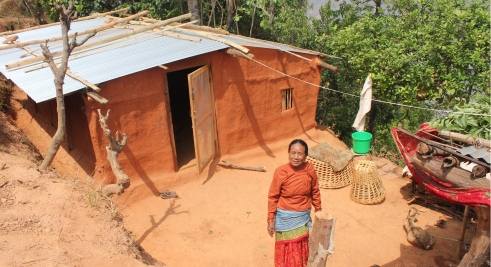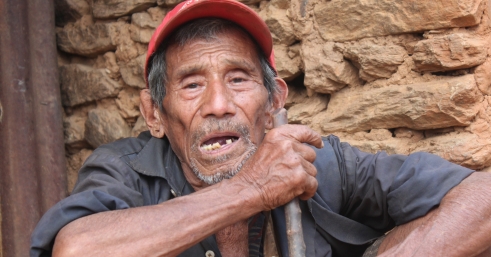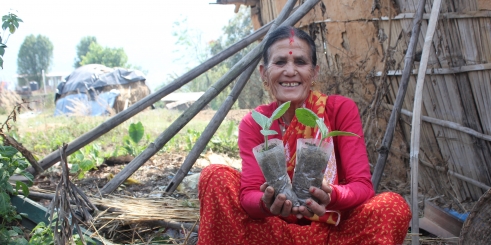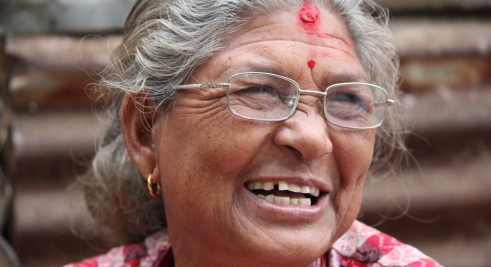By Ben Small
At 11.56am local time, one year ago on Monday, a 7.8-magnitude earthquake struck Nepal. Nearly 9,000 people were killed by the tremors, with more than 22,000 left injured. Whole villages were flattened and some 605,000 homes were left destroyed.
As is the case in most humanitarian disasters, older people were disproportionately affected. Despite making up just 8.1% of the population, individuals aged over 60 comprised 28.9% of those killed as a result of the earthquake, according to Nepal’s Ministry of Home Affairs.
Older people overlooked and vulnerable
Khemraj Upadhyaya, Director of HelpAge Nepal says that this can be partly attributed to the fact that the earthquake impacted rural areas predominantly. Many younger people have migrated to the less affected cities, leaving behind a higher proportion of older people. Yet it is also because men and women in their later years are less able to escape.
“If they can barely walk, then they certainly can’t run,” says Khemraj.
Lacking mobility, overlooked for humanitarian assistance, and often victims of cultural and social discrimination, older people remained vulnerable throughout the first year of recovery.
In the earthquake’s wake, HelpAge International, with funding from organisations including the DEC, HelpAge Germany, HelpAge USA and Age International, was in Nepal delivering relief to the older people most in need. Through working with our local partners the Nepal Participatory Action Network (NEPAN) and the Community Self-Reliance Centre (CSRC), we have reached tens of thousands of survivors, helping them rebuild homes, buy food to eat, and restore health and livelihoods
Giving older people a roof over their heads
Temporary shelter has been provided to 3,000 older people and their families. People just like 63-year-old Kanchi, who would otherwise be sleeping outside in the open, vulnerable to the elements.

(c) Judith Escribano/Age International
Kanchi stands in front of her temporary shelter
“When the earthquake struck, I was sitting in my doorway, looking after the chickens. I got up and saw my house fall down. Everything I owned was buried in my house,” she explained.
HelpAge provided Kanchi with a shelter kit containing 12 sheets of corrugated iron, wire, nails, a hammer and a saw. To get the structure standing, we gave her 15,000 Nepalese rupees (US$141), which she spent on a door and lock, bamboo supports, an electricity supply and to pay someone to help her build it.
Providing older people with cash to spend on what they need
We gave financial support to 10,000 older people so they can buy what they need the most.
After a disaster strikes, survivors’ circumstances are not always the same. Therefore, giving everyone the same set of items is not necessarily the most effective way to address the concerns of older men and women and their families. Providing cash transfers means survivors can spend the money on what is most pressing.
“I would not have eaten without this money,” says 85-year-old Dupha, who lived in a goat shed for two months after the earthquake flattened his house.
Dupha received 7,500 Nepalese rupees through CSRC, which he and his family spent on rice, oil, salt and spices.
“We didn’t spend any money on anything other than that which fed us,” he said.

(c) Judith Escribano/Age International
Dupha in front of his home in Nepal
Supporting older people to revive their livelihoods
Getting older people self-sufficient again after a disaster is vital. The death of livestock, destruction of tools and equipment, and a labour market left in disarray can make it very difficult to earn a steady income.
We are helping 5,000 older people change this through livelihoods support. Activities range from providing loans to help set up a shop, running incense-making workshops or teaching people how to work their farmland.
Through our partner NEPAN and her local older people’s association, we provided agricultural training and seeds to 63-year-old Saran.

(c) Judith Escribano/Age International
Saran holds her crops she was able to grow with agricultural training
“I wanted to do the agricultural training so I could improve my farming skills and start supporting myself and my family after the earthquake,” says Saran.
“We were taught how to keep our seedlings strong, not to use chemical pesticides, to use organic shampoo to kill the insects on the plants,” she continues. “We learned to grow cucumbers, green beans, betel nut, tomatoes and pumpkins.”
Saran has not harvested her crops yet, but in four months she hopes to sell the produce leftover from feeding her family at the market so she can use the cash to support her family.
Health camps and eyecare
“I can walk safely and even do very minute tasks. Now, I can tell the different between rice and stones!” says Tarka, 67.

(c) Judith Escribano/Age International
Saran wears her new glasses
In the wake of the earthquake, older men and women saw their health suffer. With the damage to local infrastructure, it has become much harder for them to reach doctors and clinics.
Through our partners we helped 40,000 survivors get treatment and check-ups at a series of health camps. We also provided eyecare, including 5,000 cataract operations, to 30,000 people.
Tarka and her husband Bir, also 67, visited one of our health camps. Tarka had her eyes tested and received a new pair of glasses to help her get around safely. Meanwhile, Bir was given medication and eye drops to improve his blurred vision.
“I am so happy someone helped us. People don’t just die from disasters like this one. They die from the helplessness that comes after the disaster. The support we received meant we were not helpless,” said Tarka.
Older people still need help
One year on, our work in Nepal is not finished. There are older men and women who survived the earthquake who still need support to get their lives back on track – long-term assistance to ensure they are self-sufficient and resilient.
